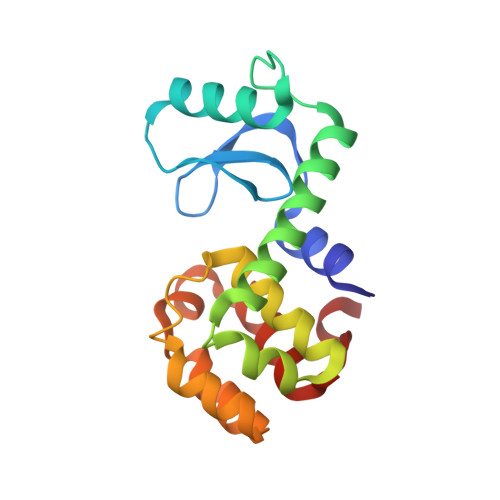Structural analysis of a non-contiguous second-site revertant in T4 lysozyme shows that increasing the rigidity of a protein can enhance its stability.
Wray, J.W., Baase, W.A., Lindstrom, J.D., Weaver, L.H., Poteete, A.R., Matthews, B.W.(1999) J Mol Biol 292: 1111-1120
- PubMed: 10512706
- DOI: https://doi.org/10.1006/jmbi.1999.3102
- Primary Citation of Related Structures:
1QUD, 1QUG, 1QUH, 1QUO - PubMed Abstract:
The mutation Glu108-->Val (E108V) in T4 lysozyme was previously isolated as a second-site revertant that specifically compensated for the loss of function associated with the destabilizing substitution Leu99-->Gly (L99G). Surprisingly, the two sites are 11 A apart, with Leu99 in the core and Glu108 on the surface of the protein. In order to better understand this result we have carried out a detailed thermodynamic, enzymatic and structural analysis of these mutant lysozymes as well as a related variant with the substitution Leu99-->Ala. It was found that E108V does increase the stability of L99G, but it also increases the stability of both the wild-type protein and L99A by essentially equal amounts. The effects of E108V on enzymatic activity are more complicated. The mutation slightly reduces the maximal rate of cell wall hydrolysis of wild-type, L99G and L99A. At the same time, L99G is an unstable protein and rapidly loses activity during the course of the assay, especially at temperatures above 20 degrees C. Thus, even though the double mutant L99G/E108V has a slightly lower maximal rate than L99G, over a period of 20-30 minutes it hydrolyzes more substrate. This decrease in the rate of thermal inactivation appears to be the basis of the action of E108V as a second-site revertant of L99G. Mutant L99A creates a cavity of volume 149 A(3). Instead of enlarging this cavity, mutant L99G results in a 4-5 A displacement of part of helix F (residues 108-113), creating a solvent-accessible declivity. In the double mutant, L99G/E108V, this helix returns to a position akin to wild-type, resulting in a cavity of volume 203 A(3). Whether the mutation Glu108-->Val is incorporated into either wild-type lysozyme, or L99A or L99G, it results in a decrease in crystallographic thermal factors, especially in the helices that include residues 99 and 108. This increase in rigidity, which appears to be due to a combination of increased hydrophobic stabilization plus a restriction of conformational fluctuation, provides a structural basis for the increase in thermostability.
Organizational Affiliation:
Institute of Molecular Biology Howard Hughes Medical Institute and Department of Physics, 1229 University of Oregon, Eugene, OR 97403-1229, USA.
















